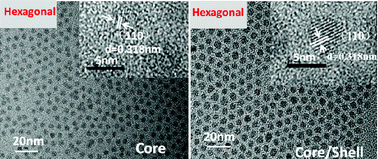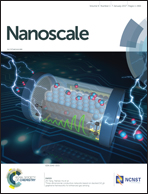Sub-6 nm monodisperse hexagonal core/shell NaGdF4 nanocrystals with enhanced upconversion photoluminescence†
Abstract
The ability to fabricate lanthanide-doped upconversion nanocrystals (UCNCs) with tailored size and emission profile has fuelled their uses in a broad spectrum of biological applications. Yet, limited success has been met in the preparation of sub-6 nm UCNCs with efficient upconversion photoluminescence (UCPL), which enable high contrast optical bioimaging with minimized adverse biological effects entailed by size-induced rapid clearance from the body. Here, we present a simple and reproducible approach to synthesize a set of monodispersed hexagonal-phase core NaGdF4:Yb/Ln (Ln = Er, Ho, Tm) of ∼3–4 nm and core/shell NaGdF4:Yb/Ln@NaGdF4 (Ln = Er, Ho, Tm) UCNCs of ∼5–6 nm. We show that the core/shell UCNCs can be up to ∼1000 times more efficient than the corresponding core UCNCs due to the effective suppression of surface-related quenching effects for the core. The observation of prolonged PL lifetime for the core/shell than that for the core UCNCs demonstrates the role of the inert shell layer for the protection of the core. The achievement of sub-6 nm NaGdF4 UCNCs with significantly improved luminescence efficiency constitutes a solid step towards high contrast UCPL optical imaging with secured biological safety.


 Please wait while we load your content...
Please wait while we load your content...